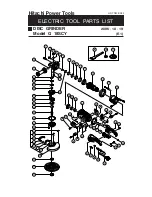
Model G0952 (Mfd. Since 09/21)
-9-
Additional Safety for Metal Belt Grinders
Serious injury or death can occur from fingers, clothing, jewelry, or hair getting pinched/
entangled in rotating belt or other moving components. Abrasion injuries can occur from touching
moving grinding belt with bare skin. Workpieces or ground-off particles thrown by grinding belt
can strike operator or bystanders, causing impact injuries or blindness. Long-term respiratory
damage can occur from using grinder without wearing a respirator. To reduce the risk of these
hazards, operator or bystanders MUST completely heed the hazards and warnings below.
MINIMUM STOCK DIMENSION.
Small
workpieces can be aggressively pulled from your
hands, causing contact with belt surface. Always
use a jig or other holding device when grinding
small workpieces, and keep hands and fingers at
least 2" away from abrasive surface.
FLAMMABLE MATERIALS. Grinding metal will
cause sparks. Make sure there are no flammable
or combustible materials near machine.
ABRASIVE DIRECTION. Feeding workpiece
incorrectly can cause it to be thrown from machine,
striking operator or bystanders, or causing hands
to slip into moving belt. To reduce these risks, only
grind against direction of sandpaper travel, ensure
workpiece is properly supported, and avoid intro-
ducing sharp edges into moving belt on the lead-
ing side of the workpiece.
PROTECTING HANDS. Rotating belt can remove
skin quickly. Always keep hands away from mov-
ing belt during operation. Do not wear gloves while
grinding. Stop machine before cleaning dust from
work area and protect hands because pieces can
be sharp.
FEEDING WORKPIECE. Forcefully jamming
workpiece into abrasive surface could cause it
to be grabbed aggressively, pulling hands into
abrasive surface. Firmly grasp workpiece in both
hands and ease it into belt using light pressure.
AVOIDING ENTANGLEMENT.
Becoming
entangled in moving parts can cause severe injury
or death. Keep all guards in place and closed; DO
NOT wear loose clothing, gloves, or jewelry; and
tie back long hair.
IN-RUNNING NIP POINTS. The gap between
moving grinding belt and table/support creates a
pinch point for fingers or workpieces; the larger
this gap is, the greater the risk of fingers or
workpieces getting caught in it. Minimize the risk of
pinch and crush injuries by adjusting table/support
to no more than
1
⁄
16
" away from belt.
GRINDING DUST. Grinding creates large amounts
of airborne dust particles that can cause eye injury
or respiratory illness. Reduce your risk by always
wearing approved eye and respiratory protection
when using grinder.
ABRASIVE CONDITION. Worn or damaged grind-
ing belts can fly apart and throw debris, or aggres-
sively grab workpiece, causing injury from opera-
tor loss of workpiece control. Always inspect belt
before operation and replace if worn or damaged.
HOT WORKPIECES. Grinding friction will cause
workpiece to quickly get hot, causing burns to the
skin. Wear apron if grinding for an extended time.
Do not touch freshly ground surfaces or nearby
areas without first cooling them or allowing them
to cool.
WORKPIECE INTEGRITY & SUPPORT. Grinding
fragile workpieces can result in loss of control,
resulting in abrasion injuries, pinch/impact inju-
ries, or damage to abrasive belt. Only grind solid
workpieces that can withstand power grinding
forces. Properly support workpiece; avoid grinding
workpieces without flat bottom surfaces unless
some type of jig is used to maintain support and
control when grinding force is applied. Always
grind with workpiece firmly against table or anoth-
er support device.
Содержание G0952
Страница 36: ......












































